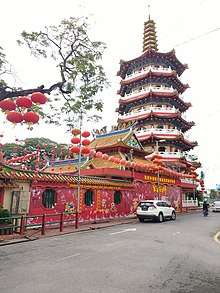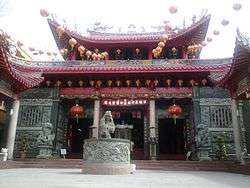Tua Pek Kong
Tua Pek Kong (Chinese: 大伯公; pinyin: Dàbó Gōng, Hakka: Thai phak koong, Hokkien: Tuā-peh-kong, Cantonese: daai6-baak3-gung1, Malay: Topekong, Indonesian: Toa Pekong). lit. "grand uncle") is one of the pantheon of Malaysian, Indonesian and Singaporean folk religions.[1] Throughout Southeast Asia, Tua Pek Kong is referred as the "God of Prosperity",[2] where he is thought to be an incarnation of the god "Fu" from the trio of "Fu Lu Shou" representing "Prosperity, Fortune and Longevity" or a sailor from Fujian who sacrificed himself for a fellow human.[3]

Background
Tua Pek Kong was a man named Zhang Li (张理) from the Hakka clan.[1] His Indonesian Sumatra-bound boat was struck by wind and accidentally landed on Penang Island in present-day Malaysia, which at that time had only 50 inhabitants. He is believed to have arrived in the island 40 years earlier than Francis Light in 1746. After his death, the local people began worshipping him and built the Tua Pek Kong Temple there where he was buried behind the Sea Pearl Island Tua Pek Kong Temple in Tanjung Tokong.[1] The story of the first Tua Pek Kong in Penang demonstrates the tradition of sworn brotherhood between the Chinese diaspora:
[Zhang Li] lived in the small community of fisher folks [sic] as a teacher. He was known for his kindness and friendliness – the villagers never failed to seek his guidance and help if had any problems. Two men became his sworn brothers – Chiu Hsiao Ching, a charcoal maker, and Ma Fu Choon, a blacksmith. As he was the eldest, he was addressed by the young in the village as Tuah Pek Kong [sic]. The trio seemed very much attached to one another. When the day's work was done, they would meet each other without fail in their favourite place in the village. One day, as the records continue, Chiu and Ma, as usual, went to meet their respected elder but were shocked to find him sitting motionless beside a huge boulder! They tried to awaken him but soon realised that their revered elder was no more alive [sic]. A sense of gloom seemed to overwhelm the residents of the village who helped to bury him beside the boulder. Chiu and Ma eventually died and they, too, were buried there beside their sworn eldest brother. Today, the "graves" of the trio can be found just behind the [Sea Pearl Island Tua Pek Kong] temple.[1]
Since then, he has been worshipped by Malaysian Chinese throughout the country. Tua Pek Kong is often mistaken for Tu Di Gong, partially because of their physical similarities. Between 1865 until 1868, Chung Keng Quee was a principal donor to the Haichu-yu (Sea Pearl) Tua Pek Kong Temple in Tanjung Tokong, Penang.
Temples
The oldest and the first Tua Pek Kong Temple in Malaysia is located in Tanjung Tokong, Penang which was established in a fishing village no later than 1792 that eventually sprouts the worship of Tua Pek Kong throughout West Malaysia, Singapore, East Malaysia and parts of Indonesia.[2] In the foot of Bukit Cina (Chinese Hill) in Malacca City, the Poh San Teng Temple is dedicated to Tua Pek Kong.[4] In Sarawak of East Malaysia, there is around 76 known Tua Pek Kong temples scattered throughout every Chinese settlement in the state;[5] some of the famous temples is the Tua Pek Kong Temple, Kuching,[6] the Tua Pek Kong Temple in coastal Miri which is built after an epidemic in the town,[7] and the Tua Pek Kong Temple, Sibu with its 7-storey pagoda that has become one of the landmark for Sibu.[8] In Batam of Indonesia, one of its notable Tua Pek Kong Temple is located in Nagoya,[9] while in Singapore its most notable Tua Pek Kong temples is located in Balestier, Loyang, Kusu Island and Ubin.[10][11][12][13][14]
 Tua Pek Kong Temple, Kuching, Malaysia
Tua Pek Kong Temple, Kuching, Malaysia.jpg) Tua Pek Kong Temple, Marudi, Malaysia
Tua Pek Kong Temple, Marudi, Malaysia Pagoda of Tua Pek Kong Temple, Sibu, Malaysia
Pagoda of Tua Pek Kong Temple, Sibu, Malaysia Hoo Ann Kiong Temple, Riau, Indonesia
Hoo Ann Kiong Temple, Riau, Indonesia Tua Pek Kong Temple, Batam, Indonesia
Tua Pek Kong Temple, Batam, Indonesia.jpg) Fo Shan Ting Da Bo Gong Temple, Ubin, Singapore
Fo Shan Ting Da Bo Gong Temple, Ubin, Singapore
See also
- Ancestor worship
- Chinese mythology
- Fengshui
- Shenism in Southeast Asia
- Superstition of Malaysian Chinese
- Malaysian folk religion
- Kusu Island
References
- Jack Meng-Tat Chia (2017). "Who is Tua Pek Kong? The Cult of Grand Uncle in Malaysia and Singapore" (PDF). Archiv Orientální. ISSN 0044-8699 – via ResearchGate.
- Jean Elizabeth DeBernardi (2006). The Way that Lives in the Heart: Chinese Popular Religion and Spirit Mediums in Penang, Malaysia. Stanford University Press. pp. 177–. ISBN 978-0-8047-5292-3.
- "Religion comes to town". Asian Geographic. Archived from the original on 20 February 2019. Retrieved 20 February 2019.
“Tua Pek Kong” in Hokkien (Fujian) dialect (as it is popularly known to Southeast Asian Chinese) or “Dabogong” in Mandarin is thought to be an incarnation of the god “Fu” from the trio of “Fu Lu Shou” representing Prosperity, Fortune and Longevity, or a Fujian sailor who sacrificed himself for a fellow human. Others think he was originally a scholar, Zhang Li, or even the “god of the earth”.
- Lonely Planet; Simon Richmond; Isabel Albiston (1 June 2017). Lonely Planet Kuala Lumpur, Melaka & Penang. Lonely Planet Global Limited. pp. 332–. ISBN 978-1-78701-060-4.
- Chang Yi (3 January 2016). "The name Sibu predates its establishment". The Borneo Post. Archived from the original on 20 February 2019. Retrieved 20 February 2019.
In almost every Chinese settlement, there is a Tua Pek Kong temple and as a result, there are 76 known Tua Pek Kong temples in Sarawak.
- Galileo Petingi (27 February 2014). "Tua Pek Kong Temple, Kuching, Sarawak". The Daily Roar. Archived from the original on 20 February 2019. Retrieved 20 February 2019.
- Cindy Lai (5 May 2010). "Tua Pek Kong always remembered and revered by Miri folk". The Star. Retrieved 20 February 2019.
- Conny Banji (4 December 2013). "Tua Pek Kong Temple very much a tourism icon". The Borneo Post. Archived from the original on 20 February 2019. Retrieved 20 February 2019.
- Widodo (14 March 2010). "Turis Nyaman di Klenteng Tertua Batam" [Point of interest in Batam's Oldest Temple] (in Indonesian). Tribun News. Archived from the original on 22 February 2019. Retrieved 22 February 2019.
- "Loyang Tua Pek Kong". Loyang Tua Pek Kong. Retrieved 22 February 2019.
- Naidu Ratnala Thulaja (1 September 2016). "Loyang Tua Pek Kong Temple". National Library Board, Singapore. Archived from the original on 22 February 2019. Retrieved 22 February 2019.
- "Fo Shan Ting Da Bo Gong Temple". National Parks Board, Singapore. Archived from the original on 22 February 2019. Retrieved 22 February 2019.
- https://www.roots.sg/Content/Places/landmarks/balestier-heritage-trail-historical-landmarks-of-balestier/Goh-Chor-Tua-Pek-Kong-Temple
- https://www.roots.sg/learn/resources/ich/pilgrimage-to-kusu-island